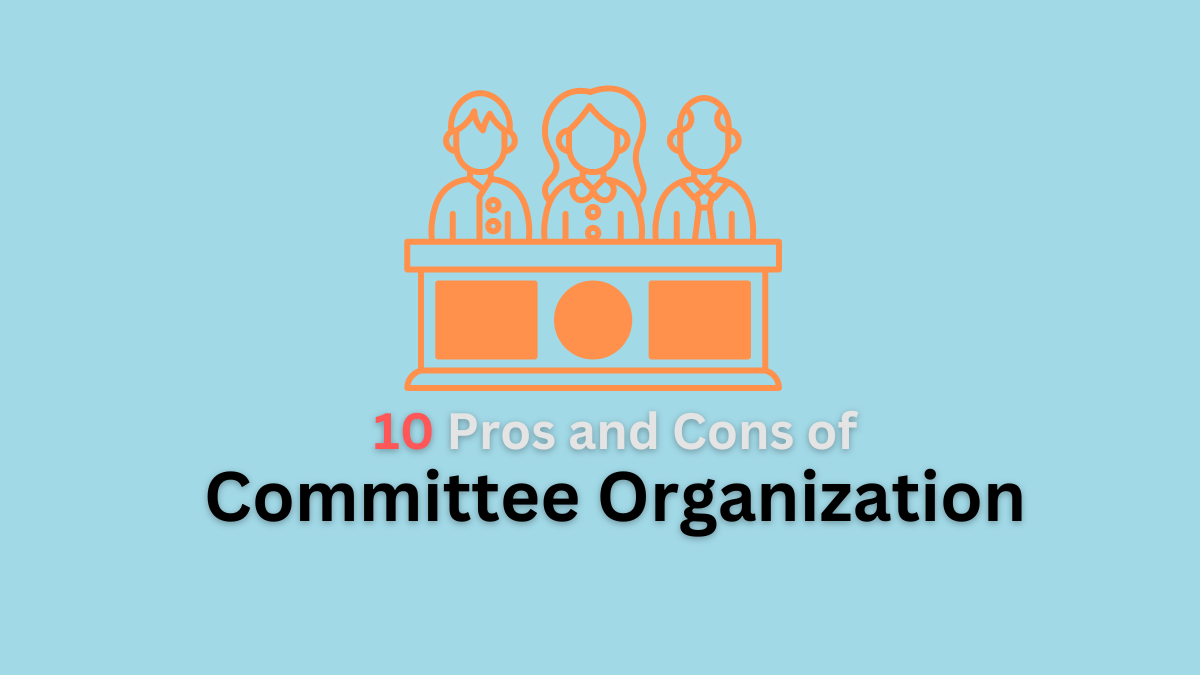Pros and Cons of Committee Organization
A committee organization refers to a structured framework where committees are established within an organization to facilitate decision-making, problem-solving, and policy formulation. In this article, we will explore the 10 major pros and cons of committee organization in business:
Pros of Committee Organization
Committees provide various benefits in the workplace, below are the five main advantages of committee organizational structure in the workplace:
Pooling of Knowledge and Experience
Committees bring together individuals with diverse backgrounds, skills, and expertise. This pooling of knowledge allows for a thorough examination of issues from multiple perspectives. Different viewpoints ensure that decisions are well-informed and comprehensive, minimizing the risk of subjective or biased decision-making.
According to the information provided, “Group deliberations and combined judgment of all the members can be brought to bear on important problems,” enhancing the quality and robustness of decisions.
Improved Communication
Committees serve as crucial communication channels within organizations. They facilitate the exchange of information, ideas, and policies both vertically (upward and downward within the hierarchy) and horizontally (across departments or functional areas).
Effective communication helps clarify objectives, resolve ambiguities, and foster creativity through collaborative interactions among members.
Facilitation of Coordination
Participation in committee meetings promotes mutual understanding, teamwork, and cooperation among employees. Committees often include members from different departments or levels of the organization, allowing for integration and alignment of diverse perspectives towards common organizational goals.
This coordination ensures that decisions and actions are aligned with broader organizational strategies and objectives.
Enhanced Motivation and Morale
Involvement in decision-making processes through committees can significantly boost employee morale and motivation.
When employees feel their opinions are valued and their voices heard, they develop a sense of ownership and commitment to the organization’s success. This active participation not only improves job satisfaction but also fosters a culture of engagement and empowerment within the workforce.
Read More: 10 Major Pros and Cons of Job Rotation in HRM
Executive Development and Training
Committees serve as valuable platforms for developing leadership and managerial skills among employees. Participation in committee discussions exposes managers and executives to complex organizational challenges, encouraging them to adopt a holistic view of decision-making.
This exposure enhances their ability to analyze issues critically, collaborate effectively, and contribute meaningfully to organizational success over the long term.
Disadvantages of Committee Organization
With numerous benefits, committee structure also comes with some drawbacks, below are its five main disadvantages:
Indecisiveness and Delay in Decision-making
Committees often face challenges in reaching timely decisions due to prolonged discussions, conflicting viewpoints, and the need for consensus-building among members.
As highlighted, “Members of a committee tend to indulge in lengthy discussions. Every member has the right to speak and be heard.” This indecisiveness can hinder organizational agility and responsiveness, particularly in fast-paced or crises where prompt action is essential.
Read More: Pros and Cons of Functional Organization
High Costs and Resource Intensiveness
Maintaining committees involves significant costs in terms of time, resources, and administrative overhead. These include expenses related to convening meetings, providing allowances to members, and managing documentation and follow-up activities.
The resource-intensive nature of committee work can sometimes outweigh its benefits, especially if the outcomes do not justify the investment in terms of improved decision quality or organizational effectiveness.
Compromised Decisions and Mediocrity
Committee decisions may often reflect compromises aimed at appeasing divergent opinions rather than pursuing optimal solutions. As noted, “Committee decisions are often mediocre compromises between conflicting viewpoints.”
The pressure to achieve consensus can lead to decisions that fail to fully address complex issues or capitalize on innovative ideas, resulting in outcomes that are acceptable but not necessarily optimal or innovative.
Read More: 10 Major Pros and Cons of Line Organization
Diffused Responsibility and Accountability
Individual accountability can become diluted within committees, as no single member bears sole responsibility for decisions or outcomes.
This diffusion of accountability can lead to a phenomenon known as “social loafing,” where members may not exert maximum effort or take ownership of their roles. Consequently, decision implementation and follow-up actions may lack the necessary clarity and commitment needed for effective execution.
Potential for Dominance and Groupthink
Committees may be susceptible to domination by a few vocal or influential members, leading to a disproportionate influence on decision outcomes.
Moreover, group dynamics can sometimes suppress dissenting viewpoints or innovative suggestions in favor of conformity (groupthink). This conformity bias can stifle critical thinking and limit the exploration of alternative perspectives, undermining the quality and creativity of decision-making processes.
Hence, the above-mentioned are the 10 main pros and cons of committee organization in the workplace.
Read Next: 10 Major Pros and Cons of Job Enrichment
